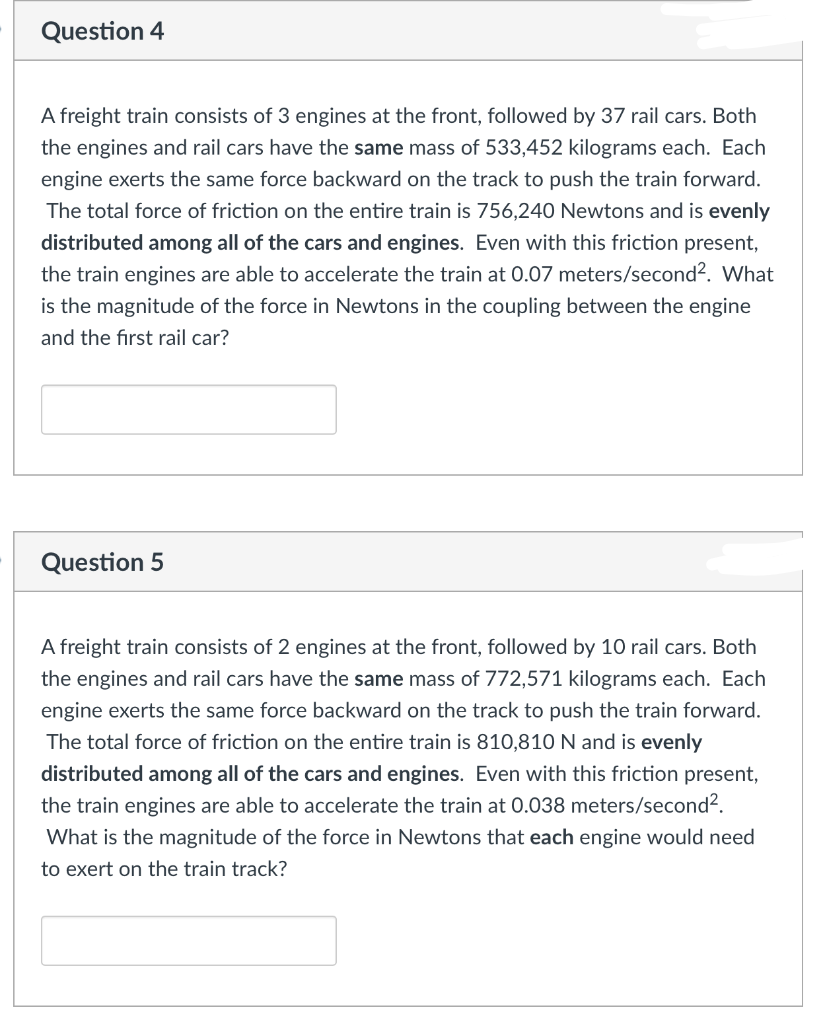A freight train consists of 3 engines at the front, followed by 37 rail cars. Both the engines and rail cars have the same mass of 533,452 kilograms each. Each engine exerts the same force backward on the track to push the train forward. The total force of friction on the entire train is 756,240 Newtons and is evenly distributed among all of the cars and engines. Even with this friction present, the train engines are able to accelerate the train at 0.07 meters/second². What is the magnitude of the force in Newtons in the coupling between the engine and the first rail car?
A freight train consists of 3 engines at the front, followed by 37 rail cars. Both the engines and rail cars have the same mass of 533,452 kilograms each. Each engine exerts the same force backward on the track to push the train forward. The total force of friction on the entire train is 756,240 Newtons and is evenly distributed among all of the cars and engines. Even with this friction present, the train engines are able to accelerate the train at 0.07 meters/second². What is the magnitude of the force in Newtons in the coupling between the engine and the first rail car?
College Physics
10th Edition
ISBN:9781285737027
Author:Raymond A. Serway, Chris Vuille
Publisher:Raymond A. Serway, Chris Vuille
Chapter4: The Laws Of Motion
Section: Chapter Questions
Problem 9P: As a fish jumps vertically out of the water, assume that only two significant forces act on it: an...
Related questions
Topic Video
Question

Transcribed Image Text:Question 4
A freight train consists of 3 engines at the front, followed by 37 rail cars. Both
the engines and rail cars have the same mass of 533,452 kilograms each. Each
engine exerts the same force backward on the track to push the train forward.
The total force of friction on the entire train is 756,240 Newtons and is evenly
distributed among all of the cars and engines. Even with this friction present,
the train engines are able to accelerate the train at 0.07 meters/second². What
is the magnitude of the force in Newtons in the coupling between the engine
and the first rail car?
Question 5
A freight train consists of 2 engines at the front, followed by 10 rail cars. Both
the engines and rail cars have the same mass of 772,571 kilograms each. Each
engine exerts the same force backward on the track to push the train forward.
The total force of friction on the entire train is 810,810 N and is evenly
distributed among all of the cars and engines. Even with this friction present,
the train engines are able to accelerate the train at 0.038 meters/second².
What is the magnitude of the force in Newtons that each engine would need
to exert on the train track?
Expert Solution
This question has been solved!
Explore an expertly crafted, step-by-step solution for a thorough understanding of key concepts.
This is a popular solution!
Trending now
This is a popular solution!
Step by step
Solved in 2 steps with 2 images

Knowledge Booster
Learn more about
Need a deep-dive on the concept behind this application? Look no further. Learn more about this topic, physics and related others by exploring similar questions and additional content below.Recommended textbooks for you

College Physics
Physics
ISBN:
9781285737027
Author:
Raymond A. Serway, Chris Vuille
Publisher:
Cengage Learning

College Physics
Physics
ISBN:
9781305952300
Author:
Raymond A. Serway, Chris Vuille
Publisher:
Cengage Learning

Principles of Physics: A Calculus-Based Text
Physics
ISBN:
9781133104261
Author:
Raymond A. Serway, John W. Jewett
Publisher:
Cengage Learning

College Physics
Physics
ISBN:
9781285737027
Author:
Raymond A. Serway, Chris Vuille
Publisher:
Cengage Learning

College Physics
Physics
ISBN:
9781305952300
Author:
Raymond A. Serway, Chris Vuille
Publisher:
Cengage Learning

Principles of Physics: A Calculus-Based Text
Physics
ISBN:
9781133104261
Author:
Raymond A. Serway, John W. Jewett
Publisher:
Cengage Learning

Glencoe Physics: Principles and Problems, Student…
Physics
ISBN:
9780078807213
Author:
Paul W. Zitzewitz
Publisher:
Glencoe/McGraw-Hill

University Physics Volume 1
Physics
ISBN:
9781938168277
Author:
William Moebs, Samuel J. Ling, Jeff Sanny
Publisher:
OpenStax - Rice University

College Physics
Physics
ISBN:
9781938168000
Author:
Paul Peter Urone, Roger Hinrichs
Publisher:
OpenStax College